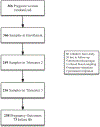Anaemia and iron deficiency in pregnancy and adverse perinatal outcomes in Southern India
- PMID: 31296936
- PMCID: PMC10122513
- DOI: 10.1038/s41430-019-0464-3
Anaemia and iron deficiency in pregnancy and adverse perinatal outcomes in Southern India
Abstract
Background/objectives: We examined the prevalence of anaemia, iron deficiency, and inflammation during pregnancy and their associations with adverse pregnancy and infant outcomes in India.
Subjects/methods: Three hundred and sixty-six women participating in a randomised trial of vitamin B12 supplementation were monitored to assess haemoglobin (Hb), serum ferritin (SF), hepcidin, C-reactive protein (CRP), and alpha-1-acid glycoprotein (AGP) during pregnancy. Women received vitamin B12 supplementation (50 µg per day) or placebo daily; all women received daily prenatal iron-folic acid supplementation. Binomial and linear regression models were used to examine the associations of maternal iron biomarkers with pregnancy and infant outcomes.
Results: Thirty percent of women were anaemic (Hb < 11.0 g/dl), 48% were iron deficient (SF < 15.0 µg/l), and 23% had iron deficiency anaemia at their first prenatal visit. The prevalence of inflammation (CRP > 5.0 mg/l: 17%; AGP > 1.0 g/l: 11%) and anaemia of inflammation (Hb < 11.0 g/dl, SF > 15.0 µg/l, plus CRP > 5.0 mg/l or AGP > 1.0 g/l: 2%) were low. Infants born to anaemic women had a twofold higher risk of low birth weight (<2500 g; risk ratio [RR]: 2.15, 95%CI: 1.20-3.84, p = 0.01), preterm delivery (RR: 2.67 (1.43-5.00); p = 0.002), underweight (WAZ < -2; RR: 2.20, 95%CI: 1.16-4.15, p = 0.02), and lower MUAC (β(SE): -0.94 (0.45)cm, p = 0.03). Similarly, maternal Hb concentrations predicted higher infant birth weight (p = 0.02) and greater gestational age at delivery (β(SE): 0.28 (0.08) weeks, p = 0.001), lower risk of preterm delivery (<37 weeks; RR: 0.76, 95%CI: 0.66-86, p < 0.0001); and higher infant MUAC (β(SE): 0.36 (0.13) cm, p = 0.006). Maternal SF concentrations were associated with greater birth length (β(SE): 0.44 (0.20) cm, p < 0.03). Findings were similar after adjusting SF concentrations for inflammation. IDA was associated with higher risk of low birth weight (RR: 1.99 (1.08-3.68); p = 0.03) and preterm birth (RR: 3.46 (1.81-6.61); p = 0.0002); and lower birth weight (p = 0.02), gestational age at birth (p = 0.0002), and infant WAZ scores (p = 0.02).
Conclusions: The prevalence of anaemia and iron deficiency was high early in pregnancy and associated with increased risk of adverse pregnancy and infant outcomes. A comprehensive approach to prevent anaemia is needed in women of reproductive age, to enhance haematological status and improve maternal and child health outcomes.
Conflict of interest statement
References
-
- WHO The global prevalence of anaemia in 2011. Geneva: WHO; 2015.
-
- Janbek J, Sarki M, Specht IO, Heitmann BL A systematic literature review of the relation between iron status/anemia in pregnancy and offspring neurodevelopment. Eur J Clin Nutr. 2019. - PubMed
-
- McClung JP, Murray-Kolb LE. Iron nutrition and premenopausal women: effects of poor iron status on physical and neuropsychological performance. Annu Rev Nutr. 2013;33:271–88. - PubMed
-
- Murray-Kolb LE, Beard JL. Iron treatment normalizes cognitive functioning in young women. Am J Clin Nutr. 2007;85:778–87. - PubMed
-
- Haas JD, Brownlie Tt. Iron deficiency and reduced work capacity: a critical review of the research to determine a causal relationship. J Nutr. 2001;131:676S–88S. - PubMed
Publication types
MeSH terms
Grants and funding
LinkOut - more resources
Full Text Sources
Medical
Research Materials
Miscellaneous


